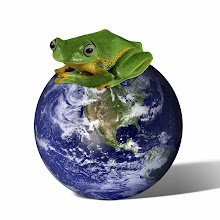I should hate botany.
I took a class on it back in college and did horribly. The final exam consisted of examining a heap of twigs, leaves and such, piled upon a table, and then deciding what were the scientific and common names of each specimen.
But I love botany – the science of plants -- even so, even if I am a mere amateur.
Plants, in such yummy forms as corn, potatoes, strawberries and beans, feed me.
Orchids and roses inspire me.
Rafflesia and coco de mer makes me smile.
Chocolate, vanilla, hot pepper and cinnamon make me happy.
And what of trees – the giants, the gods of the forest?
The first tree that I see as I step into “my” forest is a humble one – a thin sculpture of sticks with a few sparse leaves to alert me that it’s actually alive. It’s more of a bush, a pathetic little bush, than a tree. And yet, when it flowers, and when it proudly hoists its brilliant, scarlet fruit, suddenly it stands out. I posted a photo of it here a few weeks ago.
It is strawberry bush, Euonymus americanus, in the staff tree family. Also called spindle tree. Unlike the completely unrelated strawberry that you plop into your cereal bowl, this plant is not to be munched unless you are Bambi.
The website, http://www.paghat.com/strawberrybush.html, explains that:
“The plant’s bark & fruit contain the glycosides evobioside, evomonoside, & evonoside, which adds up to a powerful laxative that can at the very least cause dehydration which can alone be deadly. At worst it may have a harmful impact on the cardiovascular system. Nevertheless, Native Americans used it for sundry medicinal purposes, & deer love to browse Strawberry Bush, suffering no ill consequences.”
One of the first principles of botany is that all plants fit into certain families. Those families are typically based on flower similarities – and often, even among plants of strikingly different appearance, that family relationship leads to other similar characteristics. Poison ivy, cashews and mangoes are in the same family. All three contain certain similar oils to which many people are very allergic. Members of the rose family, such as blackberries, apples and of course, roses, have a typically reddish cast to their new growth.
It also fascinates me how within a plant family, just like a human family, “siblings” can have vastly different “personalities.” My strawberry bush, if you will forgive the anthropormorphism, is a meek little thing that struggles to rise above the tall grass at the forest edge. But it has a sibling in the family that is wild, aggressive and generally hated: Oriental bittersweet, a non-native vine, grows thickly enough to girdle and kill even the tallest trees. Do not be a fool and buy this from your local nursery, if said nursery is irresponsible enough to stock it.
Another “sibling,” Celastrius paniculatus, is used as an aphrodisiac in its native India.
Yet another sibling furnishes the African drug “khat,” which is illegal in the United States.
None of these are actually trees, even though the family goes by the Staff Tree name. Very strange.
Tuesday, October 23, 2007
The first tree in my East Coast forest
Subscribe to:
Post Comments (Atom)















6 comments:
I love your tribute to plants that nourish, gladden, and inspire you.
"It also fascinates me how within a plant family, just like a human family, “siblings” can have vastly different “personalities.”
What a wonderful depiction. Fascinates me as well.
I'm feeling the waves of plant energy wash over me.
Sending you a bouquet of blessings, MW
I love trees. Did you know that coniferous trees predate bees?? They wind pollinate. Everything else is believed to be created with the assistance of bees.
We have a tree here called a Cottonwood - It's amazing, beautiful except when it releases messy "cotton".
Ooooh, I love trees, plants, and my goodness who could ever have a grudge against chocolate...
I love the siblings analogy... this was incredibly relaxing to read...
:-)
Great Posting :-)
! that was some test !
Motherwintermoon:
I've been reading back through some of the comments on my blog and I realized that I never answered Yours. Thanks for stopping by here and I hope that You will drop in again.
Claudia:
I realize that it is environmental heresy to say this. I realize that this tree species provides some of the only shade and greenery in the West.
But I absolutely hate cottonwoods. A dark and evil part of my heart would not sorrow if a cousin to Dutch Elm Disease wiped the damn things out down to the very last sprout.
Anyone with allergies knows exactly why I feel that way. Cottonwood fluff is like a Hell's Angel compared to a spindly old dude on a moped.
Post a Comment